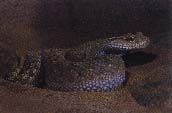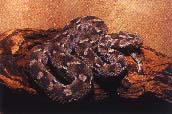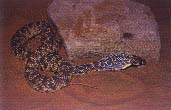by J.N. Barnes
Pictures by Kevin Hyland, Christian Gross, Chris & Tilde Stuart
The above are some of the more common snakes found in Dhofar, which are also present throughout Arabia. Several other species of snake are to be found in Arabia, but are not common in Dhofar and are therefore not included in this list. Snakes have had an undeservedly bad press, however if they are treated with respect and a few basic rules adhered to - wearing shoes when away from habitation and being vigilant - then both snakes and people should be able to share the same environment with a degree of mutual safety.
Note that colour descriptions are not a perfectly reliable guide as variations arise with location and terrain type. Specifically mentioned marking should be constant however. Note also that the approximate lengths given in centimetres are for adults.
SOLENOGLYPHS - Dangerous
Large folding fangs for delivering venom are situated in the front of the upper jaw.
 Family Viperidae
Family Viperidae
Sand or horned viper (Cerastes cerastes gasperetti) - 76 cm
The most commonly seen viper, found in a wide range of habitats from sand dunes to rocky wadis and the lower slopes of jebels. Some specimens have a horn above each eye. These small fat snakes are mainly nocturnal but can be found buried in sand with just the top of the head visible, or under rocks. They move with a sidewinding action which leaves a distinctive track in the sand. This form of locomotion protects them from the hot sand, allowing only a couple of body points to make contact with the ground at any one time. Usually inoffensive (unless trodden on), they give plenty of warning by rasping their scales together and making many dummy strikes when approached too closely. Coloration is a disruptive camouflage of browns with a distinct dark stripe through the eye.
 Carpet viper (Echis carinatus, Echis coloratus, Echis pyramidum) - 76 cm
Carpet viper (Echis carinatus, Echis coloratus, Echis pyramidum) - 76 cm
A very dangerous snake possessing one of the most toxic venoms of all land snakes. Found in rocky places or areas with vegetation around wadis and hillsides, sometimes in large numbers. Although rarely seen, carpet vipers can be aggressive and will strike after loudly rasping their scales together as a warning. Camouflaged in browns or greys, they have an arrow marking on top of the head and inverted chevrons on their sides.
Puff adder (Bitis arietnas) - 30 inches
A large stocky slow-moving viper with distinctive black and grey chevron markings. Found near vegetation and water mainly around the coastal plains and jebel areas. Often found basking in the open, they should be approached with caution; when irritated they are probably the world's fastest striking snake.
PROTEROGLYPHS - Dangerous
Short fixed fangs in the front of the upper jaw for delivering venom. Usually long, thin and fast moving.
Family Elapidae
Arabian Cobra (Naja heje arabica) - 1 m 78 cm
The only type of elapid found in Arabia, they give plenty of warning before striking, lifting the front third of their body off the ground and spreading a hood at the back of the head and neck. Cobras come in various colours, but are usually a metallic bronze. They should be treated with the utmost respect and caution.
OPISTHOGLIPHS - Not considered dangerous to humans
Short fixed fangs at the rear of the upper jaw, behind the eye,
deliver a mildly toxic venom. The Arabian species are not considered
very dangerous to humans. A few typical types are:
Family Colubridae
Hooded malpolon (Malpolon moiliensis) - 1 m 52 cm
Very common on stony desert and wadis, they often lift their front bodies off the ground and when surprised they spread a small elongated hood cobra fashion. Camouflaged with dappled dark and light brown markings and with a large dark spot behind the eye.
Cat snake (Telescopus dhara) - 1 m
A purely nocturnal snake rarely seen, but being a bird feeder it is often responsible for missing buderigars from outside aviaries. Has a very distinct stealthy hunting method, stalking up until almost touching its prey before grabbing it. Cat snakes come in a wide variety of colours, including bright pink hues.
Cliff racer, sand snake, tree snake (Psammophis schokari) - 1 m 52 cm
Probably the most frequently sighted Arabian snake, having a wide habitat and being day active. Very good climbers, these long thin snakes often appear in gardens hunting mice and geckos, and disappear with amazing speed when disturbed. Plain grey or sand brown in colour with a black and white stripe running through the eye.
AGLIPHS - Totally harmless
Some colubrids are included under the general heading Agliph - harmless snakes with no venom or fangs.
Family Colubridae
Sand racer (Coluber rhodorachis) - 1 m 27 cm
Similar to the cliff racer but without the eye stripe. Does not climb so well, but is extremely fast moving and active during the day. It is also a good swimmer, catching fish in pools (and fish pond). These snakes come in a wide variety of colours and patterns, from plain grey or brown to speckled or banded, and usually taper to a long thin tail in plain brown.
Rat snake (Coluber ventromaculatus) 36 inches
A common snake in the scrub desert and rocky wadis of Dhofar. Very similar to the sand racer in appearance except for a dark bar marking on the top of the head, ending in a comma shape around each eye. Can often be seen hiding in bushes.
Thomas' snake (Coluber thomasi) - 45 cm
A distinctive snake boldly marked with black and pale yellow bands.
To be found in rocky mountainous terrain.
Awl headed snake (Lytorhynchus diadema) - 45 cm
Sometimes known as the leaf-nosed snake due to the large scale covering the tip of the nose. Night active, they spend the day hiding in burrows. Coloured light grey/brown with dark blotches and a distinctive head marking of brown bars. Although harmless to humans they put on a quite dramatic aggression display if disturbed. The body is formed into two coils like a figure eight and then repeatedly straightened, giving loud rasping noises from the rubbing of the scales.
Family Boidae
Sand boa (Eryx jayakari) - 63 cm
The only true constrictor in Arabia, although many colubrids also use constriction as a method of subduing their prey. Recognizable by its shovel shaped head with small eyes set high on top. This small stocky yellow and brown snake spends most of its time buried in the sand.
Family Leptotyphlopidae
Thread snake (Leptoyphlops macrorhynchus)
A small pink wormlike snake that is the same diameter for almost all its length. Feeds mainly on termites and ants. These are probably the world's smallest snakes.
Web Links | Subjects | Search
Arabian Wildlife. Volume 3, Number 1